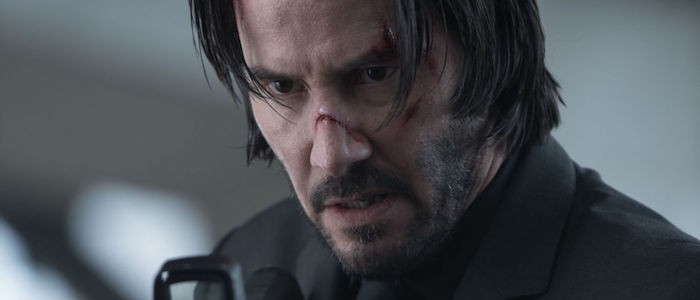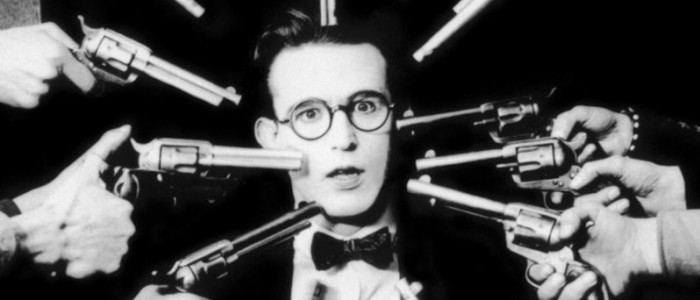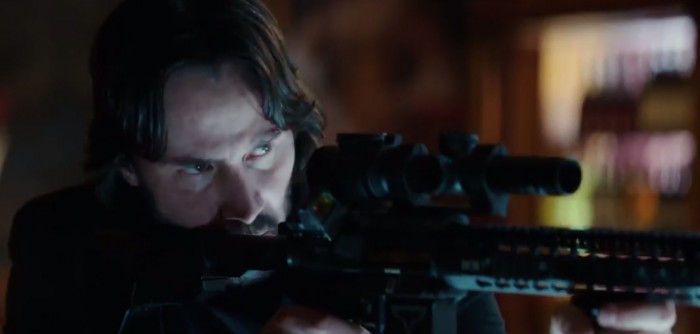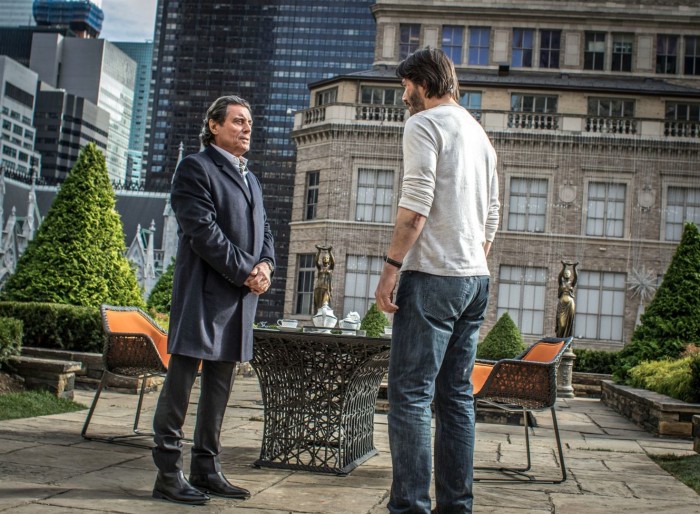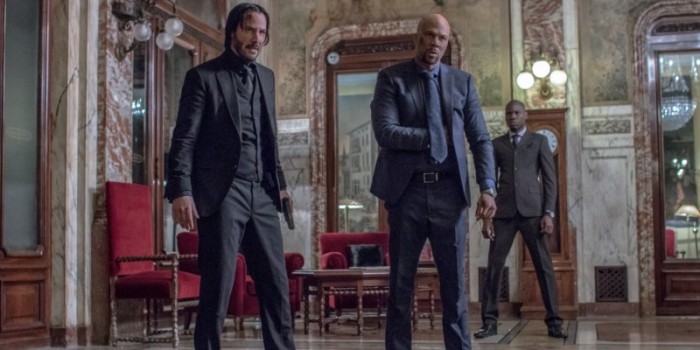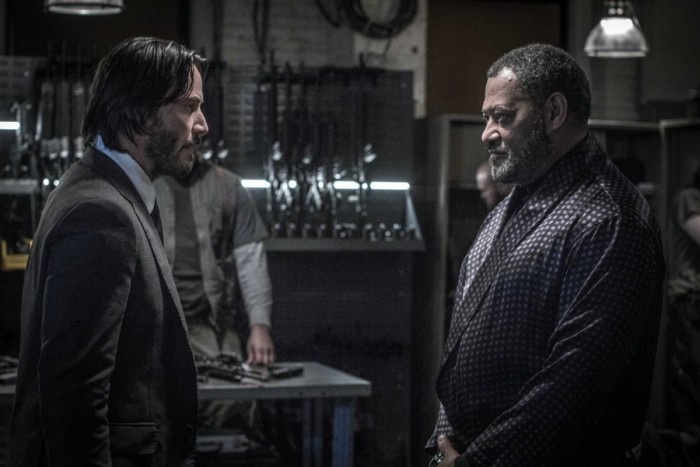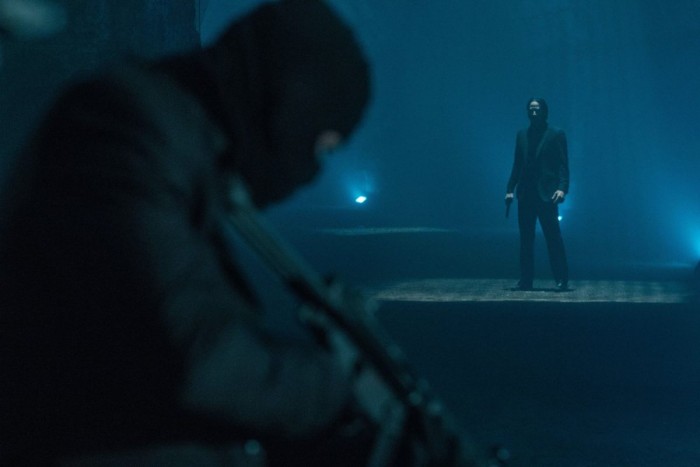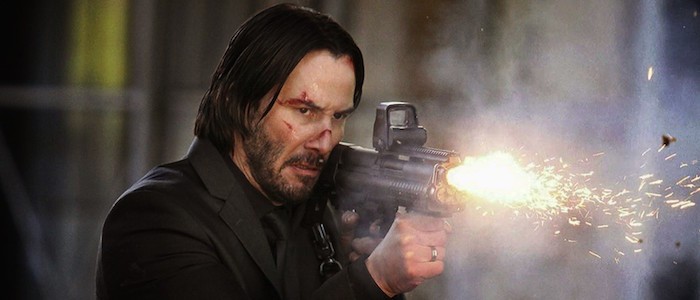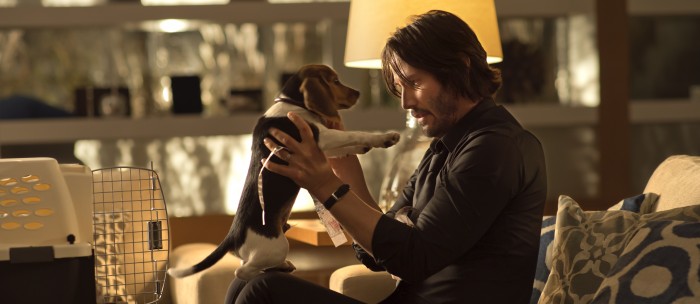Heartbreaks And Headshots: The Action Movie Majesty Of The 'John Wick' Series
John Wick and John Wick: Chapter 2 aren't just good action movies – they're perfect action movies. And they're more than that – they're great movies, filled with character and humor and detail that rewards careful consideration and thought. They also feature Keanu Reeves shooting so many people in the face, but that's just the appetizer. Come for the violence (and there's plenty of that), but linger for two of the most magical and beautifully realized genre movies of all time.
So let's take a deep dive into these movies and dissect them. Let's figure out what makes these movies so good and how they utilize Reeves so well, and explore their debt to everything from silent comedies to ancient mythology. Because the John Wick movies aren't just a ton of fun – they're art.
Spoilers for both movies lie ahead.
The Very Specific Skill Set of Keanu Reeves
Let's talk about the Kuleshov effect. Named for Soviet filmmaker Lev Kuleshov, this film editing technique was developed in in the early 20th century and explored how audiences would associate the same image with different emotions through the power of montage. Kuleshov cut between the same expressionless image of an actor and a series of images, including food and a beautiful woman. Audiences formed connections that didn't exist in the performance and only in the edit – the man was hungry; the man was lustful. The performance did not change, but the association of other imagery implied that it did.
And this is why the natural blankness of Keanu Reeves is a gift to filmmakers who know how to utilize it. In the wrong hands, Reeves can appear wooden and stilted, an actor who can't quite wrap his mouth around certain dialogue and his mind around certain characters. He doesn't have an especially wide range. But what is here is a very specific set of skills, a mesmerizing deadpan, that sings when put in conjunction with the right associative material. The same zen-like blankness that allows Reeves to play a bumbling stoner also allows him to play a science fiction warrior or a hitman powered by pure vengeance. It's all about teaming Reeves with a storyteller who understands that this is a leading man who works best as a cog in a larger machine, a tool rather than an engine. He's the ultimate collaborator, a role made more powerful by his commitment to research and preparation.
Reeves' natural stillness is not something every actor can pick up – there's a fine art to doing very little. The John Wick movies have an entirely appropriate love for early silent comedies, and Reeves demands comparison with Buster Keaton, who built an entire career on maintaining a rigid composure and an expressionless face in the midst of absurd and (literally) dangerous situations. Although John Wick is a more emotional guy than Keaton's characters, his outbursts of rage and anger only come at a breaking point. For the bulk of both movies, Reeves is stone-faced, the source of an unending and intentional punchline. Yes, this all very absurd. Yes, this is all very goofy. Yes, this action is so over-the-top. But look at the face of the leading man! He's taking it so seriously. Maybe we should, too?
In director Chad Stalelski, Reeves has found a storyteller who knows how to use him best. In John Wick, he has found a character (and world) that feels like it was custom built for his specific set of skills.
Putting It All in Camera
John Wick: Chapter 2 opens with a strange image that we quickly forget about because the camera tilts down and drops us straight into a car chase. Footage of an old silent movie is projected on the wall of a Manhattan skyscraper. Who is watching it? Who is projecting it? Why are we seeing this? These questions are unimportant. It serves its purpose: it pays tribute to the performers to which the John Wick series pays tribute and it lets you know that yes, the movie is very much in on the joke.
One of the posters for John Wick: Chapter 2 (partially seen at the top of this article) features Reeves staring forward, poker face at the ready, with countless guns aimed straight at his noggin. The internet wryly pointed out that this looked an awful lot like imagery from Two-Gun Gussie, a 1918 silent comedy short starring the legendary Harold Lloyd. What those who haven't given John Wick the time of day didn't realize is that this was very intentional. Lloyd, like Buster Keaton and other early film comedians, is silent cinema's equivalent of an action star. Without the use of dialogue, their jokes had to be purely visual and the most memorable of them involve genuine risk to all involved. The very nature of early film technology, including generally static cameras and the lack of sophisticated visual effects, meant that you just couldn't fake certain things. Either you did it on camera, either you risked your life for the gag, or it didn't happen.
The John Wick movies arrive a century after the heyday of the silent comedians, but they're very much a throwback to the days where filmmakers had no choice but to put it all in camera. There are modern tricks in the John Wick movies and digital technology helps ensure the safety of performers and a smoother production process, but the spirit is very much alive in how Stahelski shoots his action and how his stunt team stages it. Shots are long and avoid extreme close-ups. The faces of performers, including Reeves, are kept in frame as much as possible to make sure we know they're actually participating in the action. When someone takes a fall or when a car slams into them, the John Wick movies are making a promise: they're not faking this and they're not editing around people who don't know how to fight. These are movies that understand the visceral, giddy thrill of watching someone survive a perilous and impossible situation, especially when that perilous and impossible situation feels real.
That's not to say John Wick and its sequel are realistic films. They're patently and knowingly ridiculous, much like how Buster Keaton knew that it was patently and knowingly ridiculous for his character to survive the front of a house around him in Steamboat Bill Jr. But to pull off that famous stunt, Keaton and his team had to actually execute it, to sell something so silly as something that could actually happen...because they made it actually happen.
Similarly, the John Wick movies pad their inherent outrageousness with just enough realism to sell it. Every bullet is accounted for, with the action choreography accounting for him reloading his weapons after the proper number of shots are fired. There is no John Woo-esque cheating when it comes to the number of rounds in every magazine. Every physical encounter is shot wide enough to showcase the specific details of the struggle, revealing how Wick fights his way out of any given situation with enough real-world accuracy to suggest that maybe it's possible for him to survive his ordeal. And it certainly helps that Reeves does the bulk of his own stunts, having learned how to shoot and fight over the course of a grueling training regimen.
By putting it all in camera and adding that tinge of realism, the John Wick movies sell their ridiculousness in a way that most action movies simply cannot. And that tinge of realism is, like the leading man itself, a finely tuned deadpan that lets you know it's okay to laugh.
Defining the Action and Actions of John Wick
Throughout both John Wick movies, the supporting cast speaks of the title character in a dozen different shades of awe. Almost everyone respects his skills as a killer and those who do not tend to wind up dead. This is a typical action movie trope, the professional killer whose resume of insane accomplishments tends to inspire tough-guy monologues from key characters: "you have no idea who you're dealing with," etc.
However, the actual skills of John Wick are unlike what we see in most cinematic action heroes and they genuinely reflect why so many characters would fear him. John Wick's method of killing isn't about looking cool (which is, let's face it, the chief goal of most movie action), it's about getting the job done as quickly and efficiently as possible. The "looking cool" thing is just a side effect. John Wick is one scary guy because he doesn't pause and he never takes a single fight with a random henchman personally – all he can focus on is how he can kill his opponent as soon as possible so he can get to the next guy. He'll pause and take it personally when he gets to the final target. This is where Reeves the actor becomes so important to the action of these movies: that deadpan poker face implies a passive professionalism that kicks in when he's getting to work. This is what he does and he's good at it, thank you very much. John's outbursts ("Yeah, I'm thinking I'm back") come between the fights. When he's in the midst of a scene, he's focused only on the goal at hand.
The result, interestingly, is an action hero with a massive body count who doesn't come off like a sadist. Sure, John kills so many people and does so without breaking a sweat, but John doesn't linger – he makes sure you're as dead as fast as possible because you're an obstacle, not the goal. That's why these movies feature so many headshots (and yes, the internet is keeping score): he's saving ammunition and a shot anywhere else is just a waste of time and energy. He has to keep moving forward.
The closest contemporary comparison to Keanu Reeves' John Wick may be early Steven Seagal, whose Aikido martial arts moves were all about showcasing his speed with fast takedowns that ended fights before they could even really get started. However, there's a natural arrogance to Seagal as an actor, a sense that his quick fighting style is more about showing off than anything else. This is only emphasized by the ham-fisted monologues Seagal tended to deliver to his opponents in the pauses between breaking their bones, explaining their sins and self-aggrandizing while baiting them in for another shattered wrist. Despite the "peaceful warrior" vibes his movies attempt to create, there's an inherent sadism there. In comparison, there is no arrogance to John Wick – his speed isn't about showing off. It's about pushing onward. It's about finishing the job. It's about actually being the best, instead of just being the guy that everyone monologues about being the best.
A Comic Book Fantasy Land
Any modern filmmaker is treading on thin ice it comes to movies as violent as John Wick and John Wick: Chapter 2. How do we cheer on gun violence and rampant violence like this? Isn't that irresponsible? Potentially. Maybe. It's certainly a conversation worth having and it would probably be a bigger deal if these films were only about their action and only about watching Keanu Reeves put many bullets in many faces. But they're not. In fact, the key to the power of John Wick is that these movies simply do not take place in our world – they're fantasy films set in an alternate reality that might as well be Middle-earth.
Actually, a more accurate comparison may be J.K. Rowling's Wizarding World, which takes place just beneath the surface of the recognizable world and focus on a war that we cannot see. It's noteworthy that the only "real" person in the John Wick series is the title character's wife, who has passed away when the first movie begins. There are no key civilians in John Wick or John Wick: Chapter 2 – just professional killers and those who work for them. The violence of John Wick never extends to the real world, never takes the lives of the innocent, and is present only amongst those who have chosen this life. Honestly, John Wick shooting his way through a nightclub populated by mafia goons feels more like the Fellowship of the Ring battling their way through Moria than an actual shootout. In this heightened reality, the average henchman is just an Orc, waiting to be slain.
John Wick is not based on any existing source material, but the world screenwriter Derek Kolstad has created feels like a '90s Vertigo comic book series torn from an alternate dimension. The beauty is in the details: the Continental hotels, which service professional assassins and enforce rules that require no business be conducted on their grounds, allowing sworn enemies to share drinks in the bar. A secret currency system of gold coins, which are used in lieu of cash to pay for everything from a cocktail to a bulletproof suit to "dinner reservations," AKA corpse removal services. A rigid hierarchy of assassins that must be respected.John Wick: Chapter 2 expands this criminal fantasyland, offering a series of modules for the original's Core Rulebook. There's the mysterious office where tattooed women dressed like '60s secretaries make assassination requests official via outdated technology. There's Laurence Fishburne's Bowery King, a criminal mastermind who operates out of a soup kitchen and commands an army of faux homeless people. And then there's the mysterious High Table, the organization that oversees this entire kingdom and will not be questioned. This is the kind of action movie that demands a handwritten map next to the title page, where New York City and Rome are not the cities we know, but fantastical lands filled with mysterious shopkeepers and characters willing to sell magical artifacts (lots and lots of guns) for the right price (a handful of gold coins).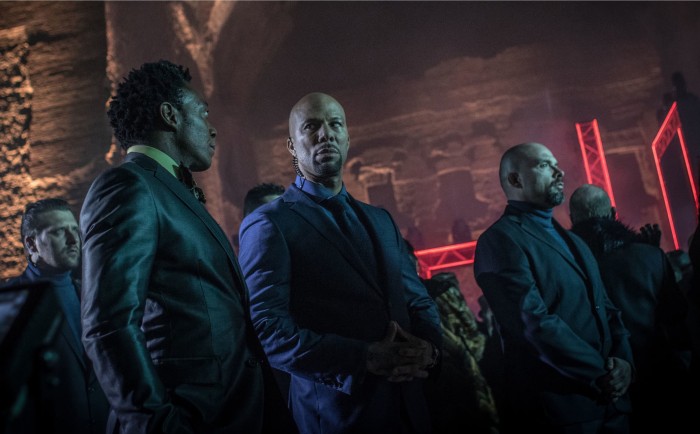
The universe of John Wick is big and every tiny revelation, every implied backstory, makes it feel even larger. It's the kind of movie where every supporting character demands a spin-off movie, from Common's Cassian to Ian McShane's Winston. When characters recognize John Wick (and everyone recognizes John Wick), the sense of history is palpable. There's a George R.R. Martin-esque history waiting to be written about the power struggles and relationships of this world. And because these movies focus squarely on John himself, placing us squarely within his specific cone of vengeance, we're allowed to imagine everything we cannot see for ourselves. After all, John knows everything we don't, so we why would he (or the movie) slow down to fill us in? He's got places to be and people to kill. We can only wonder about the mysteries that may never have answers and that is a rare feeling to associate with any action movie.
Not Without a Sense of Humor
It cannot be overstated how funny the John Wick movies are and how their silly sense of humor goes a long way to selling this world and its characters. Just start with the inciting incident of the first movie: someone kills John Wick's dog, so he kills everyone. That's ridiculous. That's hilarious. That's the film's deadpan once again coming into full effect and making magic happen.
The comedy seeps into every crevice not occupied by blood and bullets. It's Michael Nyqvist's Viggo Tarasov casually muttering "Oh" after he's learned that his son has killed John's puppy and made off with his prized car. It's John and Cassian engaging in a gunfight in the middle of a crowded subway terminal with silenced weapons while none of the jaded New Yorkers notice. It's so many characters being flabbergasted by the tales of John Wick killing several men with a pencil, only for the movie to actually build a fight scene around Keanu Reeves fighting two guys while being armed only with a pencil. It's John telling his new dog to stay in the lobby of the Continental, only for the adorable pup to stare right at Lance Reddick's concierge Charon and reveal that the only deadpan more effective than Reeves' may be that damn dog's.
A Journey to the Underworld
In order to return to the life he left behind, to avenge his puppy (i.e., to avenge the destruction of the promise of a new life), John Wick must descend a flight of stairs to his basement and smash the concrete floor with a sledgehammer, revealing the weapons he hid long ago. This very literal descent is no accident, as the fantasy action world of John Wick takes the concept of a "criminal underworld" very literally. By returning to the life he left behind, John is returning to Hell.
This isn't the hell of Dante, though. It's a less rigidly defined underworld, one that has more in common with Greek myth than Judeo-Christian depictions of the afterlife. While John was able to escape this realm, others are happy to live here and revel in it, to make a business out of it. It's no accident that the Continental concierge Charon is named after the ferryman who carries newly arrived souls across the rivers Styx and Acheron, delivering them to the realm of Hades. It's also no accident that the currency of this underworld are gold coins, as coins were once left upon the dead to pay for this passage. It's certainly no accident that there's a massive shootout in ancient Roman catacombs in the middle of John Wick: Chapter 2 – a resting place for the dead becomes a playground for the so-called living.
And that's why death carries so little weight in the world of John Wick, why the lead character can murder hundreds of people without blinking an eye and why not even the most human characters blink in face of a gun barrel. They're already dead. They've made a home in Hell. And as John learns in John Wick: Chapter 2, getting out of Hell isn't as easy as simply walking back up those stairs.
The Labors of John Wick
So how did John Wick escape this underworld the first time? How did he win those precious few years with his late wife? He completed an "impossible task," the details of which have yet to be explored. In other words, we're talking about a warrior who escaped Hell by completing an impossible mission for powerful forces. If that sounds like the template of a tale torn straight out of classical mythology, you'd be right.
The John Wick movies don't skimp on the religious iconography. Characters meet (and later, fight) beneath giant statues of Roman gods. The Virgin Mary stands guard in the Bowery King's basement while a mural declares that "Jesus Saves" upstairs. The crime lord Santino D'Antonio learns that John Wick is coming for him while standing beneath the gaze of Durga, the warrior goddess of Hinduism. A statue of an angel overlooks John's final scene in the second film, as judgment is cast down upon him. As John Wick kills and kills again, the gods are always watching and always judging. But are they intervening? Is John truly fighting alone?
John Wick is no god. He can be battered, he can be stopped in his tracks. He has limited control of his destiny. But he is Achilles and Hercules and Odysseus, the brilliant warriors and heroes of myth and legend who tackle impossible odds, who achieve the mighty and the impossible when the gods were on their side and fall into death and despair when the Powers That Be turn against them. In most classical cases, these heroes fall victim to they own hubris, hoisted on their own petard. For John, his weakness, his Achilles' heel, is something a bit more tragic: he simply cannot fill the gaping hole in his existence, the spot that his humanity used to occupy. There is no longer a Penelope to fight for – there is simply a death spiral into the world he longs to escape.
The first John Wick put its title character in control of the action: the quest of vengeance against those who wronged him was his and his alone. He was in charge, he drove the action, and the entertainment value came from watching this mighty warrior effortlessly kill ever single bad guy. Isn't that the core of so many legends? The great hero ventures forth and conquers all who oppose him? It is up until a point. Eventually, the unstoppable hero must face a reckoning. After all, Hercules was compelled to complete twelve increasingly impossible feats, or labors, after going mad and murdering his family. It was only natural that John Wick would face labors of his own after losing his family. Hercules had to kill the Lernaean Hydra and clean the Augean stables in one day – John Wick has to fight a sumo wrestler assassin and navigate a hall of mirrors filled with people who want to kill him.
So John Wick: Chapter 2 gleefully reverses the first film's dynamic. John is no longer powering forward – he's back on his heels, facing enemies that are perfectly capable of killing him and odds that are stacked against him. He takes plenty of beatings, takes his fair share of bullets, and generally spends the bulk of the film suffering for his sins and the sins of his enemies. There's a dizzying joy to watch John Wick barely scraping by after the superhuman antics of the first movie. The stakes feel real because we know John Wick doesn't bleed easily and he bleeds an awful lot in John Wick: Chapter 2.
Never Enough Bullets
For all of the world-building and mythological references and outrageous action and goofy jokes, John Wick always returns to one thing: its hero is in pain. Not just because everyone is punching him and shooting him and stabbing him, but because he's lost his wife and that really f***ing hurts. Most action movies trivialize dead spouses, using them as basic motivation to spur a hero into action. That's not the case with John, whose grief is so strong that he can only try to fill it with the bodies of dozens of men. Revenge becomes his lifestyle, his coping mechanism, a relapse back into bad habits after the person keeping him in check departs.
It's telling that John Wick: Chapter 2 always finds John running out of bullets. In the catacombs shootout, he empties a pistol and a rifle and shotgun before being forced to fight with his own two hands. When he's stalked through the streets of New York by a series of assassins, he's forced to improvise as every gun doesn't offer enough shots to keep his foes at bay. He even walks into the film's climax with only seven rounds and spends the final 20 minutes of the movie desperately collecting ammunition from his fallen foes to stay on top of the situation. There are never enough bullets to get the job done and it's only natural that he's forced to fight Ruby Rose's Ares (hey, another Greek myth reference) in hand-to-hand combat.
Has there ever been a better metaphor for an action hero failing to find solace in violence? John Wick delivers headshot after headshot. He makes every bullet count and everyone who stands in his way gets shuffled right off their mortal coil. No amount of killing, no amount of violence, will ever be enough to help John. All he will do is continue to fire round after round into the abyss, emptying the magazine and searching for another one. If there is a way to escape, he hasn't found it yet and his heartbreak has blinded him to other possible avenues.
A Bloody Work of Art
Early in John Wick: Chapter 2, John sits with Santino D'Antonio in an art gallery, the camera framing them against a massive painting depicting a violent war scene. It's a moment of calm in movie that is otherwise wall-to-wall with the sounds of gunfire and breaking bones. But here's a reminder that violence isn't just lurking around the characters at all times – it's something that can be immortalized, that can be rendered on canvas and hung in a museum and appreciated for centuries to come.
Later, John engages in a gun battle in that very gallery, splattering the walls with the blood of his enemies. If a battle from hundreds of years ago can find space on a museum wall, is the work of John Wick also not worthy of artistic consideration? Is the most talented hitman to ever murder his way across New York not an artist in his own right? It's Stahelski's cheeky way of reclaiming the action movie as a genuine accomplishment, to stand up for a genre that gets shuffled under the rug. "This is art," John Wick: Chapter 2 declares in its climax.
And it's hard to argue with that. The John Wick movies borrow the language of B-movie schlock to build something grander, something more ambitious. They're an example of modern myth-making, built on a foundation designed by silent movie comedians and ancient poets, a form further evolved by everyone from Jackie Chan to Arnold Schwarzenegger. They are near perfect examples of their genre and proof that mainstream American action cinema can be as compelling and rich beautifully crafted as any other movie.
Put John Wick and John Wick: Chapter 2 on a gallery wall. Stand back. Take it all in. They don't need to need to paint a portrait of John Wick's war. They already made two movies.
***
John Wick: Chapter 2 is in theaters now.

